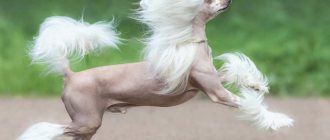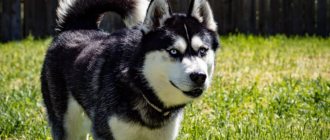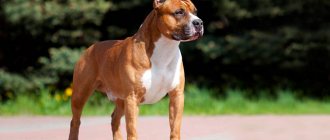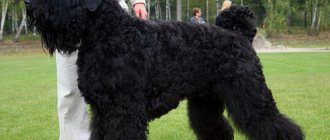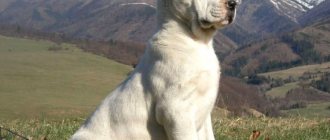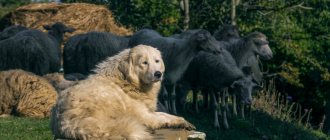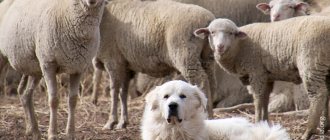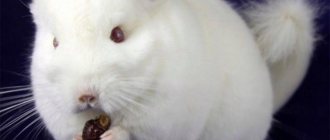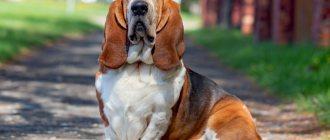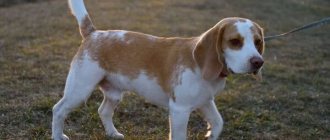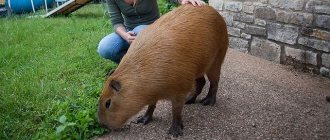Japanese dogs reflect the samurai spirit of the inhabitants of the Land of the Rising Sun. They are reserved, independent, selflessly devoted to their owners and have exceptional fortitude. This small group contains a record number of breeds, whose loyalty and ingenuity were reflected in films and captured in monuments.
Breeds are conventionally divided into two groups: native Japanese and those bred by crossing with foreign relatives. The breeding of the former is controlled by the Association for the Preservation of the Japanese Dog (Nippo). They are also considered national treasures of Japan.
In the review I described all Japanese dog breeds with photographs . You will learn about the similar and different features of the appearance and character of each representative. I also indicated the key points in care, maintenance and education.
Other selections: Russian dog breeds, American dog breeds
Akita Inu
The Akita Inu is the most famous Japanese dog breed, one of six in the Nippo registry. She was made famous by a dog named Hachiko. After the death of the owner, for 9 years he waited for him every day at the station, where he returned after work. A monument was erected to a faithful friend, and two films were made based on the story: a Japanese and an American remake.
The Akita breed originated in the Japanese province of the same name, on the island of Honshu. This is one of the 14 most ancient breeds, whose ancestors accompanied people back in the 2nd millennium BC. e. Initially it was used to catch large animals, today it is kept as a companion.
Akita Inu is the largest Spitz-type dog. Its height reaches 61–67 cm, and its weight is 40–50 kg. The breed is distinguished by its hard, straight coat with abundant undercoat. Acceptable colors are red-fawn, sesame, brindle and white. For all colors, except the last one, the so-called. “urajiro” - light hairs on the sides of the muzzle, chest, body, neck and tail.
You can keep an Akita in an apartment, house or enclosure. Care is simple: the coat is washed 2-4 times a year, combed once a week, and during the molting period - 3-4 times. Difficulties arise only with education and training. Like all Japanese dogs, the breed is stubborn, independent and listens only to those who have earned its respect.
Red dogs.
Care and maintenance
Caring for a clean and unpretentious chin is absolutely simple. It is advisable, of course, to take him for a walk three times a day, but it is permissible to limit himself to one walk, having accustomed the dog to a home litter box. In bad weather, you can walk with your dog, holding it in your arms, or dress your pet in a waterproof overall. During hot weather, it is advisable to walk your dog in the shade, as overheating may cause the dog to suffocate. For walks with your chin, choose not a collar, but a chest harness - a kind of harness, since its neck is quite delicate. Please note that these dogs, being without a leash, can easily climb the first height they come across, for example a children's slide, so you need to make sure that the little pet does not fall and injure itself.
Japanese Chin with Yorkshire
Caring for the coat of the Japanese Chin is also not difficult. He does not need model hairstyles, and the haircut is only hygienic, requiring only the removal of overgrown hairs. It would be good to brush your pet daily; in any case, this procedure should be performed at least twice a week, accustoming the dog to it from puppyhood.
Cinchona is bathed as needed, but not more than once every two weeks. Paws and ears are washed as they become dirty. For bathing, use zoo shampoos, which, in addition to the cleaning effect, also have antimicrobial and antiparasitic properties. After washing with shampoo, treat the dog's coat with conditioner - this will make it fluff up and smell nice. After the procedure, the Japanese Chin must be dried so that it does not catch a cold. You can use a towel or hairdryer.
As an alternative to bathing, you can use a dry method of cleaning the animal's fur using a special powder. Some owners use talc or baby powder for this procedure. The product should be carefully rubbed into the pet’s fur, making sure that some of it gets on his skin. After powdering, thoroughly comb the animal's fur until the powder disappears completely. This method allows you to effectively clean the coat of dirt and dead hair.
Grooming of the Japanese Chin
The claws of Japanese Chins grow very quickly, while they bend and split, which causes discomfort to the dog. They should be trimmed using a nail clipper as they grow, usually at least once a month. The dog will be especially grateful to the owner for this cosmetic procedure.
The diet of chins should be high in calories. These dogs don’t eat much, but they move very actively, even when living in an apartment. The diet should include foods containing sufficient amounts of protein and calcium. For animals of this breed, the following products are preferred and must be alternated: turkey meat, chicken, lean beef, boiled liver, tripe, kidneys, sea fish (no more than once a week), boiled yolk (two to three times a week). Periodically you need to give rice, boiled vegetables, raw pitted fruits.
The finished food must be premium or holistic.
It is important not to overfeed your chin, because it quickly gains excess weight, and this negatively affects its health. It is advisable that the gentle Japanese Chin be periodically examined by a veterinarian for preventative purposes. For animals of advanced age, veterinary examinations are recommended to be carried out regularly.
For animals of advanced age, veterinary examinations are recommended to be carried out regularly.
It is advisable that the gentle Japanese Chin be periodically examined by a veterinarian for preventative purposes. For older animals, veterinary examinations are recommended regularly.
Japanese Chin after shower
American Akita
The American Akita was bred from the Akita Inu. The first representatives from Japan were brought to the United States after World War II, where they quickly became popular.
To create a new type of dog, Americans crossed Akitas with German shepherds and mastiffs. The resulting breed was called the "Big Japanese Dog". It differs from its eastern relatives in its massive build, variety of colors and more docile character.
Otherwise the breeds are similar. American Akitas are also freedom-loving and independent, like their Japanese relatives. Maintenance and care are also the same: a large Japanese dog is kept in an apartment or outside the city, washed several times a year and combed every week.
History of the Thai Ridgeback breed
Thai Ridgeback
The four-legged inhabitants of eastern Thailand are among the original breeds, the development of which occurred without the intervention of breeders, according to the laws of natural selection. The history of Ridgebacks began about 3-4 thousand years ago - the first mentions of the breed date back to this period of time. They are represented by ancient drawings from Thailand and Cambodia, which depict similar dogs - presumably the ancestors of the Thai Ridgeback. They can be recognized by their erect ears and sickle-shaped tail. Here and there a characteristic ridge (comb of wool) can be seen on the backs of the animals.
The ancestors of the “Thais” also found their place in written sources. The Ayuth manuscript, dating from the first half of the 17th century, mentions dogs that have many similarities with modern Ridgebacks. There are no more precise “evidence” that would help trace the history of the breed, so the origin of these dogs is a closely guarded mystery. Most breeders adhere to the following version: Thai Ridgebacks are the result of a union of Aboriginal dogs and wild dingoes.
A share of uncertainty is inherent in the homeland of animals. Officially, island and mainland Thailand are considered to be the distribution range of Ridgebacks, but Indonesia is increasingly being named as a possible habitat for the first representatives of the breed.
In some ways, dogs are related to mongrels, if we interpret this word in the generally accepted sense. During the history of their existence, Thai Ridgebacks have not crossed with other breeds and appeared in the wild. The hot climate of the country forced the animals to get rid of their massive physique and thick coat. Each generation of Thai mongrels acquired more and more similarities with modern representatives of the breed.
The small distribution area of dogs became the reason for forced inbringing - mating of closely related individuals. Animals unsuitable for survival died, giving way to strong and hardy brothers
Then they were noticed by local residents who needed universal working dogs for hunting and property protection.
Thai Ridgeback puppy
The first attempts to domesticate wild animals began. Like all four-legged aborigines, the ancestors of Thai Ridgebacks were distinguished by their freedom-loving and independent disposition. For this reason, animals posed a danger even to their owners, not to mention strangers. However, attempts to domesticate wild dogs have not stopped. Ridgebacks were valued for their intelligence and agility. These qualities allowed the Thais to use animals as shepherds and draft power.
Ridgebacks were no less useful for hunting. Dogs accompanied the aborigines in hunting deer, tapirs, large wild boars and even birds. The lightning-fast reaction of animals made them indispensable companions for hunters. The courage with which dogs could rush at dangerous snakes and thereby save their owner from death was also useful.
The symbiosis of people and Thai Ridgebacks lasted until the 19th century. Along with technological progress, colonialists also came to the lands of the island of Phu Quoc (Phu Quoc), who took a liking to charming and unusual dogs. Ridgebacks caused a similar reaction among European merchants who traded with Thai aborigines. Word of a possibly new breed reached the leading dog handlers of the time. Having organized an expedition to Thailand, dog breeders were amazed: a previously unknown variety of dogs appeared before them!
It was impossible not to notice the characteristic feature - a ridge growing along the spine. There were no similar dogs among the known breeds, so dog experts decided to popularize the discovered animals.
Among the first countries to officially recognize Thai Ridgebacks were Thailand and Japan (1989 and 1990, respectively). Other states were in no hurry to jump to conclusions regarding the uniqueness of dogs. Only three years later, the international canine organization FCI registered the new breed and approved its standard. At that time, Ridgeback stud books numbered more than five thousand dogs.
Although two decades have passed since then, “Thais” still remain one of the least numerous breeds. Thai Ridgebacks are bred not only in their historical homeland, but also in America, as well as countries in Europe and Asia.
Thai Ridgeback light fawn color
Thai Ridgeback black color
Jomon-shiba
Jomon Shiba are the smallest among native dog breeds: height - 32-40 cm, weight - 6-10 kg. Their ancestors accompanied people a thousand years ago, in the so-called. “Jōmon period”: hence the name of this Japanese breed.
Unfortunately, the breed was lost for a long period. Until the Nippo organization began reviving it based on the Shiba Inu in 1928.
The Jomon Shiba has a more “wild” and ferocious appearance than the Shiba Inu. Externally, the dogs are similar to the extinct Japanese wolves. In addition, they are more difficult to train: dogs are stubborn, willful, fearless, and often aggressive towards other dogs and people. They need a special approach and early socialization.
The small size of jomons allows them to be kept in an apartment. But long walks are needed: at least 2–3 hours a day. And the fur sheds a lot, so the fur coat is combed at least twice a week.
On topic: Dogs for keeping in an apartment
Kai
The Kai (also brindle dog or tora) is another native Japanese dog breed listed in the Nippo registry. This is a medium-sized dog (45–50 cm and 11–25 kg). It is distinguished by black spots on the tongue and brindle color: pure, with a predominance of red or black.
The endurance, agility and courage of the breed allow the Kai Inu to be used as a universal hunter. It copes equally well with any game: from pheasants to bears. But today, Torah is more often taken as a companion.
Brindle dogs are amazing. They become strongly attached to their owner and selflessly protect him, cannot tolerate family changes, and with proper socialization they get along well with other animals and strangers. They are also clean, smart, independent, excellent swimmers and able to climb sloping trees.
Kai is a rare breed even in Japan. No more than 900–1,100 new puppies are registered per year.
Kishu
Kishu is another ancient breed from the Land of the Rising Sun, recognized as a national treasure. It has the typical external features of Japanese breeds: a triangular head, pointed erect ears, a curved tail and double coat. The color is most often white, but there are also representatives with a red or zone color.
Kishu is a rare breed. There are not many dogs even in Japan: about 11–13 thousand. And outside the country they are generally difficult to meet.
Despite their average size (49–52 cm), kishu are fearless hunters of large animals. They bravely drive bears and wild boars, hold them until the hunter arrives, jumping onto the back of the prey and clinging to it with their teeth. Pets can also guard the territory or herd livestock.
Kishu are unpretentious and can live in the harshest conditions. They don't care about heat or cold. But minimal care is needed: washing once every couple of months, weekly brushing, brushing teeth and ears, and trimming nails as they grow.
Breeds of white dogs with names and photos.
Shikoku
Shikoku joins the Akita Inu and Shiba Inu in the group of dogs elevated to the status of Japan's National Treasure. However, unlike the two above-mentioned breeds, Shikoku are much less common. In this regard, acquiring such a pet (if we mean a purebred individual) will be very, very difficult.
Shikoku Inu
Shikoku, like its related breeds, were formed in the vastness of the mountains, which allowed them to develop thick and fluffy wool that protects animals from the cold. The impassable mountainous terrain contributed to better preservation of the Shikoku breed features, which remained unchanged over the centuries.
By the way! The World Canine Association included Shikoku in the list of breeds only in the eighties of the twentieth century.
Character traits
Among the characteristic features that allow us to get a general idea of Shikoku, we list the main ones:
- passionate hunters by nature, Shikoku dogs simply cannot sit in one place for a long time. For them, movement is life. Therefore, it is not recommended to keep representatives of the breed in cramped apartments in an urban environment;
Shikoku Inus love snow and cold climates, but have a harder time adapting to heat.
- The flip side of hunting inclinations is increased aggression towards other animals. Not all individuals exhibit this trait clearly. However, the results of Shikoku's interactions with other dogs or cats are often unpredictable;
- slight excitability does not allow Shikoku to be left alone with small children who do not yet know how to calculate their strength. But representatives of the breed get along well with older children, taking part in their games;
- The watchdog genes predetermined Shikoku's distrust of all strangers. If such a dog believes that its owner is in danger, it will certainly use its sharp fangs to protect its “leader”;
In order to avoid various “emergency situations”, it is important to keep Shikoku on a leash at all times in crowded places.
- Despite their obstinacy, Shikoku are easy to train with the right approach. They are ready to carry out the commands of their owner, if the person himself does not try to suppress the pet and shows respect for him.
Buying puppies
Unfortunately, those people who decide to buy a Shikoku puppy will most likely have to fly to another country. There are no nurseries engaged in breeding this breed on the territory of the Russian Federation. Of course, there are single owners of these individuals, but they do not breed them on a professional level. The closest kennels to Russia that have Shikoku dogs are located in Estonia.
It is very difficult to purchase purebred Shikoku Ino puppies.
Of course, the best option is to travel directly to the homeland of Shikoku. In Japan, puppies of this breed are paid from one hundred to two hundred thousand yen, or from six to twelve thousand dollars.
Ryukyu
Ryukyu is a medium-sized dog: weight varies from 15 to 20 kg, weight - from 46 to 55 cm. The breed looks intimidating and resembles a wild dog. In fact, they are loyal, affectionate and obedient companions. Although, like all “Japanese”, they are freedom-loving and willful.
Ryukyu love their owner and family very much. But they are wary of strangers, sometimes aggressive. And their hunting instincts do not allow them to get along with other animals.
The breed originated on the Ryukyu island archipelago. It almost disappeared during World War II. Restoration began in the 1980s. But even today representatives are rare: there are only about 1,000 dogs.
The color of the Ryukyu is usually brown, less often brindle with a predominance of red, black or white.
It is better to keep Ryukyu in a country house with a large fenced area. If you keep them in an apartment, you will need daily walks lasting at least 2-3 hours. The rest of the care is simple: weekly brushing, as well as cleaning the ears and teeth.
Kai-ken
This breed has several names, but the names most often used to designate it are “Kai-ken” or brindle dog. The calling card of the breed is its unusual coat color, which in part actually resembles the skin of a tiger. Like other native breeds, brindle dogs were raised in isolated geographical conditions, which allowed them to successfully maintain the purity of the breed. Since ancient times, Kai-kens have been used to hunt various wild animals, such as wild boars, deer and even bears.
Kai-Ken
The negative side of such isolation was the small number of livestock. The Kai-ken is considered a very rare dog even in Japan itself, where representatives of the breed are carefully protected. The reason for the sharp decline in the breed is the temporary indifference of the Japanese to indigenous dogs, associated with the importation of new European individuals back in the twentieth century.
Character traits
The character of dogs of the Kai-ken breed was formed inextricably linked with their main function - pursuit of prey and assumes the presence of the following traits:
friendliness. The hunter's habits do not prevent brindle dogs from showing their good nature. Kai-ken are open to adults and patient when playing with children. At the same time, it is not recommended to keep these dogs under the same roof as cats;
devotion to the owner. Like other hunting breeds, the Kai-ken literally lives for one person, to whom he gives most of his attention. However, brindle dogs develop such relationships only with those owners who do not allow themselves unnecessary things (screams, pressure and other methods of rough influence); activity
In the absence of hunting, it is very important for Kai-kens to be able to waste their energy reserves. Therefore, keeping such pets in an apartment in the city center is inappropriate
Brindle dogs are not intended for large capitals;
Best articles: At what speed does the Earth move around its axis and the Sun?
intelligence. Loyalty and intelligence are an excellent combination when training a pet, especially if the brindle dog trusts its owner in everything and follows his instructions with pleasure.
Health status
Tiger dogs, like many other native breeds, have strong immunity. The purity of the gene allowed Kai-ken dogs to protect themselves from predisposition to many diseases. Unfortunately, even such strong purebred dogs can have health problems.
The most common pathologies for brindle dogs are:
- hip dysplasia;
- elbow dysplasia;
- hyperthyroidism;
- retinal atrophy.
Representatives of the Kai-Ken breed are susceptible to various forms of dysplasia
With proper attention from a veterinarian, all these ailments can be avoided or at least their progression can be significantly slowed down.
Sanshu
The Sanshu is another ancient Japanese dog breed that was lost and revived by enthusiasts in the early 20th century. Her ancestors accompanied the emperors, protecting their lives and protecting their peace. And today pets are excellent watchdogs, faithful companions and devoted family members.
Sanshu is a rare breed, almost never found outside of Japan. Also, it has not yet been recognized by major canine organizations.
Sanshu is distinguished by its medium size (41–46 cm and 20–25 kg), a fox face, triangular ears and a tail thrown over the back. The color is varied: white, red, brown, tan, black, gray or pepper and salt.
Sanshu are unpretentious. They can live in a house or apartment, and hygiene procedures require periodic brushing, bathing, and examination of ears and teeth. The main thing is to pay attention to nutrition and disease prevention. If you take proper care of your pet, he will live to be 15–17 years old.
History of the origin of the breed
The Chinese Crested dog has been known for a long time - an exotic, graceful and mysterious breed in the world. The dog breed is popular in China and Europe. This is due not only to its attractive appearance. The Chinese Crested is a talisman and symbolizes prosperity.
Representatives of the breed attract glances and attract attention. Dogs have bare skin, large ears, and a fluffy mane.
If you look closely, it resembles a skate in appearance, but has the gracefulness of a deer. If we consider the downy appearance, then the individuals are covered with wool - long and soft. The build is stocky.
The origin story is unknown, everything is shrouded in mystery. As you know, the breed is considered ancient in the world. According to some assumptions, the genus originates from African hairless dogs, which include subtropical Mexican, Egyptian, and Peruvian hairless dogs.
The species was first mentioned 1 thousand years BC. Since dogs personified love, they were treated with reverence and respect. For a long period of time, dogs served as a kind of heating pads.
If we look at the legends, it becomes clear that many aborigines believed that crested dogs were capable of healing people. The Indians still believe that a hairless dog breed can relieve toothache, headaches, rheumatism, and colic.
The breed was first mentioned in 200 BC in China. The best ones were owned by nobles and noble people; dogs symbolized prosperity and good luck.
Since the 16th century, it was customary to take dogs with you on all trips. As you know, the Chinese loved to travel by sea. For this reason, the breed quickly spread to other territories. Thus, the Chinese Crested appeared in America and Spain. Dogs appeared in Britain and France only in the 19th century. However, they were brought from Africa and Asia.
The official date of appearance of the Chinese Crested Dog is 1966. During this period, a cargo of four dogs arrived from China - 1 male, 3 females. British cynologists were involved in selection, breeding and approval. For this reason, the UK is considered to be the country of origin.
Sakhalin Husky
The Japanese call Sakhalin or Gilyak Laikas Karafuto-ken. Initially, the breed originated in the Amur region and Sakhalin. But in the 30s of the 20th century they were purposefully exterminated in their homeland. At the same time, the dogs were taken to Japan, where they were revived.
Sakhalin Huskies are considered an endangered breed. Work is still underway to restore and increase the number.
Sakhalin residents are sled dogs. They were also used to bait bears and sea animals. They are smart, brave and very resilient. In terms of working qualities, they are superior to Siberian Huskies, Malamutes and other breeds.
The breed went down in history thanks to an amazing incident. In 1958, Japanese researchers had to leave 15 Sakhalin huskies in Antarctica. Scientists expected to pick them up soon, but due to worsening weather they were able to return only a year later. Surprisingly, people found two surviving dogs. In honor of them and the dead dogs, a monument was erected in Japan, and two films were made: “Antarctica” and the American remake “White Captivity”.
Shiba Inu
The Shiba Inu is the most popular of the six native Japanese breeds. Declared a national treasure in 1936.
Despite its small size (7–13 kg and 36–40 cm), the Shiba Ken is an ancient hunting breed. Her ancestors hunted birds, wild boars, bears, and deer. Today the dog has retained its hunting instinct. But years of selection and popularization have turned the pet into a loving and faithful family member.
However, the Shiba has not lost its inherent “Japanese” features. She is freedom-loving, unobtrusive, reasonable. Her trust and respect must be earned. The Japanese believe that raising a breed is akin to making origami: it must be soft and consistent so as not to spoil the dog’s delicate psyche.
The Shibu Inu has many amazing traits. For their cleanliness and independence, dogs are often compared to cats. But the most unusual feature of the breed is its penchant for contemplation. Dogs can spend hours admiring the flow of the river or the sunset.
The Shiba Ken is usually a red dog. But black and tan, white or zone suits are also found. Grooming is standard: occasional bathing, periodic brushing, teeth and ear cleaning.
Shiba is another legendary dog. A dog of this breed led rescuers to the house of its owners after an earthquake in 2004. The events are depicted in the film “The Story of Marie and Three Puppies.”
Detailed description of the Shiba Inu breed.
Shikoku
Shikoku or Kochi looks like a wolf. And has the same endurance, strength and flexibility. The breed originated in the Middle Ages. It was originally used for hunting wild boar and deer. Today, dogs are also used to catch animals, and also to protect the territory and are simply kept as pets.
The Kochi Inu is another native Japanese breed included in the Nippo registry. In 1938 it was recognized as a national monument. Unfortunately, there are not many Shikoku dogs: there are about 7,000 registered dogs in the country.
Shikoku is a medium-sized dog: 16–26 kg and 49–52 cm. It is distinguished by thick, coarse hair with abundant undercoat and “wild” colors: red, black, brown or sesame. Whitish hairs on the sides are required - urajiro.
Shikoku is perhaps the most docile dog among the native Japanese breeds. She is people-oriented, attached to her owner, and friendly to strangers. She learns easily and loves to work, she is not as stubborn and independent as other “Japanese”. However, it is aggressive towards other animals, so early socialization is needed.
It is better to have a Kochi-ken outside the city. But an apartment is also suitable, provided there are many hours of daily walking. Pets are clean: it is enough to wash them 3-4 times a year and brush them once a week.
Tosa Inu
The Tosa Inu or Japanese Mastiff is the only Japanese breed from the Molosser group. She was bred at the end of the 19th century in the province of the same name for dog fighting.
Tosa-ken is a large, powerful dog with well-developed muscles. Weight reaches 40–90 kg, and height – 55–60 cm. The pet is “dressed” in a smooth, close-fitting fur coat of red, apricot, fawn, brindle or black.
The Tosa Inu has mixed blood from Akitas, pit bulls, mastiffs, German pointers and Great Danes. Dogs are strong, agile, fearless. Their advantage and at the same time disadvantage is low sensitivity to pain. Because of this quality, it is not clear for a long time whether the pet is sick.
Today, the Tosu is positioned as a family dog. The pet is balanced, manageable, alert, but not aggressive towards strangers. However, it fiercely defends its territory and owners. It cannot tolerate other animals, especially dogs, and often attacks.
Tosa Inu is a dog for country living. She needs a lot of space and walks at least 1.5–2 hours a day. Short hair is easy to keep clean, but regular hygiene procedures are required: the coat is combed 2-3 times a week and washed monthly.
Diet of Central Asian Shepherds
Proper nutrition is the key to strength, good mood and excellent health in Alabai. When it comes to choosing a diet, you definitely need to consult a specialist. To do this, you can seek help from a veterinarian. You can feed the Alabai in three ways: dry food, natural food and a mixed diet. If you don’t have time to cook or buy groceries, then dry food is the best choice. Premium food can provide the animal with all the necessary vitamins and minerals. Ready-made food is balanced, but expensive.
If you want to feed the Central Asian Shepherd with natural products, then this issue must be approached with all responsibility. The animal’s diet must be well selected so that the Alabai has enough substances for proper growth and development.
The following products should be present in the diet:
- Lean meat;
- Sea fish. It should be given only boiled;
- By-products;
- Vegetables;
- Porridge. Buckwheat, oat, and rice cereals are ideal.
All of the above products should be present in the diet of the Central Asian Shepherd every day. A little less often, about once a week, the dog should be given fermented milk products and cottage cheese. The balance of proteins and carbohydrates in the Alabai diet should vary depending on the time of year.
So, in winter, the diet should consist of fifty percent proteins, and twenty percent carbohydrates. In summer everything should be the other way around. New foods should be introduced into the puppy’s diet very carefully and the body’s reaction to them should be monitored. If an allergic reaction occurs, the product should not be given the next time.
Hokkaido
Previously, Hokkaido was called Ainu-ken by analogy with the indigenous inhabitants of Hokkaido - Ainu. The new name was given to the breed in 1937, when Nippo recognized it as a national treasure.
Hokkaido - medium-sized dogs (20–30 kg and 45–51 cm), used for hunting large animals. Today they are also bred for protection and as companions.
Ainu is a rare breed. You don’t often see them even in Japan, and dogs are almost never taken outside the country. No more than 900 new puppies are registered annually.
Hokkaidos have a typical Japanese breed appearance. They have a compact body, long legs, a tail thrown over the back and an elongated muzzle. The coat is double, with coarse guard hairs and thick undercoat. Color - white, black (pure or with tan), red, brindle, sesame.
Ainu are loyal, obedient and loving companions. But they can be aggressive towards strangers and animals. It is better to keep dogs in a country house with a spacious yard. However, if you walk your pets every day for 2–4 hours, you can have them in an apartment.
Interesting: Loyal dog breeds
Dogs popular in Japan
Japanese cities are beautiful, but very cramped. It is not surprising that decorative breeds and small companions are popular there. the Shibu Inu and the Japanese Chin as pets . Those who can afford a relatively large pet buy either an Akita or a retriever . The most common breeds among dog owners are the intelligent and friendly Labrador Retrievers and Golden Retrievers .
Shitzu
The miniature fluffy beauty did not appear in China, her homeland is Tibet . But it was from China that the fashion for shitsu came. The weight of the dog can reach 8 kg, and its height is 27 cm. Shitsu has very long, variegated fur relative to the body (black individuals are occasionally found, a little more often white). This is a cute little companion. The Leo dog loves people (especially children), and is friendly, affectionate and playful. The long fur of such a pet requires constant care.
Bolonki
This is a group of decorative dogs. In Japan, they value the snow-white, curly-haired Bichon Frize (they are active, affectionate, cheerful pranksters), the shaggy Bolognese, and the charming Maltese. Their light fluffy coats require care, and the dogs themselves crave the attention of their owners; they are sociable, cheerful and playful.
Chihuahua
The smallest dogs in the world. Their weight does not exceed 3 kg . Both smooth-haired and long-haired individuals are common. These are active, energetic, curious and intelligent pets. Chihuahuas need to be protected from the cold, and they often have allergic reactions to food, household chemicals and even their owners’ perfumes.
Dachshunds
Hunting dogs, the oldest burrow dogs. An ordinary dachshund, according to the standard, reaches a weight of up to 9 kg , miniature and rabbit ones are noticeably smaller: 5.5 kg. and 3.5 kg. respectively. These are very smart, brave and balanced animals. They are hardy, independent and loyal. Owners need to monitor the health of their pet’s back and not overfeed it.
Toy poodle
A charming baby weighing no more than 5 kg. The Toy Poodle is friendly, active and highly trainable. This is a human-oriented dog with thick curly hair. He does not shed and is classified as a hypoallergenic pet. This pet is friendly to other animals and willingly plays with children.
Sheltie
A medium-sized herding dog (weight - up to 11.5 kg, height - up to 39.5 cm in males and up to 38 cm in females). Due to its small size and attractive appearance, it is popular as a pet rather than a working dog. The Sheltie is well trained and loyal to other pets. She is smart, active and loyal.
Japanese Terrier
This breed is the only one of the terrier group bred in Japan. Their breeding began at the beginning of the 20th century. The goal was to get a decorative dog that would easily adapt to life in densely populated cities.
During breeding, Italian Greyhounds, Smooth Fox Terriers, Manchester Terriers and small aboriginal dogs were crossed. The result was a miniature dog (30–33 cm and 2–4 kg), with a compact body, long legs and very short hair (up to 2 mm).
The Japanese Terrier is easily distinguished by its unique tricolor coat. The head is decorated with a black mask with red and white spots, and on the light body there are dark or reddish-brown markings.
The Japanese Terrier is an excellent dog for an apartment and a family. He is friendly, playful, and gets along with children. However, it can chase cats and rodents, and is wary and somewhat cowardly with strangers. The dog is also easy to care for: weekly brushing with a soft brush and occasional washing are enough. The only thing is that the pet cannot stand the cold, so from autumn to spring you will need clothes.
On topic: Varieties of terriers
Japanese Chin
The Japanese Chin is another toy dog breed native to Japan. It was bred from Spaniels and Pekingese.
The Japanese Chin is extremely delicate, gentle, loving and courteous. He is completely devoted to his family and gets along well with everyone: from the owner’s children to the cat. Wary with strangers, but not aggressive.
It is vital for Hin to feel part of the family. Dogs that grow up in love and affection are easy to raise. But with a lack of attention or rudeness, pets withdraw into themselves and refuse to obey.
Japanese Chins are intelligent and quickly learn commands. But this is one of the few breeds that is almost not focused on food rewards. Because of this, inexperienced owners have difficulty training.
The coat of Chins is soft, almost does not get dirty and tangle. The color is two- or three-color with red or black spots. A mandatory breed characteristic is a white mark on the muzzle.
